List of sovereign state leaders in the Philippines
The types of sovereign state leaders in the Philippine archipelago have varied throughout the country's history, from heads of ancient chiefdoms, kingdoms and sultanates in the pre-colonial period, to the leaders of Spanish, American, and Japanese colonial governments, until the directly-elected President of the modern sovereign state of the Philippines.
| Maginoo, Wangs, Rajahs, Lakans, Datus and Sultans of the Philippines | |
|---|---|
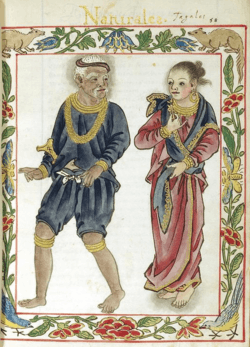 A couple belong in maharlika (Noble class). | |
| Details | |
| Style | Maharlika Kamahalan Kapunuand |
| First monarch | Jayadewa (and other various rulers from the archipelago) |
| Last monarch | Mohammed Mahakuttah Abdullah Kiram (and other various rulers from the archipelago) |
| Formation | c. 900 (according to LCI) |
| Abolition | 1986 (after last officially recognized Sultan dies) |
| Residence | Torogan – (Luzon and Visayas area) , Langgal-(Mindanao area) and Astanah Putih – (in sultanate of Sulu). |
| Appointer | Babaylan, Brahmin or Bhikkhu (In Hindu-Buddhist influenced polities). |
| Pretender(s) | various |
Archaic (pre-hispanic) Era
Before the nation of the Philippines was formed, the area of what was now the Philippines during the pre-colonial times was sets of divided nations ruled by Kings, Chieftains, Datus, Lakans, Rajahs and Sultans in Southeast Asia. It was when the Spaniards arrived that they named the collections of areas they conquered and unite in Southeast Asia as "Las Islas Filipinas" or The Islands of the Philippines.
Legendary rulers
- Legendary rulers can be found in the oral tradition in Philippine Mythology, which having an uncertain historical/archeological evidence of their reign.
| Image | Name | Title held | From | Until |
|---|---|---|---|---|
| Ama-ron | Like most of the male Filipino mythological heroes, he is described as an attractive well-built man who exemplifies great strength. Ama-ron is unique among other Filipino legends due to the lack of having a story on how he was born which was common with Filipino epic heroes. | Uncertain possibly Iron Age. | ||
| Gat Pangil | Gat Pangil was a chieftain in the area now known as Laguna Province, He is mentioned in the origin legends of Bay, Laguna,Pangil, Laguna, Pakil, Laguna and Mauban, Quezon, all of which are thought to have once been under his domain. | Uncertain possibly Iron Age. |
Archaic rulers
Wang of Ma-i
| Name | Image | Title held | From | Until |
|---|---|---|---|---|
| Gat Sa Li-han | 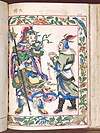 | "王" 王 (King) according to Chinese records | 1225? | ? |
| Gat Maitan | "王" 王 (King) | - | ||
Huangdom of Pangasinan (Luyag na Kaboloan)
| Ruler | Image | Event | From | Until |
|---|---|---|---|---|
| Kamayin (細馬銀) | Tribute of silver and horses to China | 1406 | 1408 | |
| Taymey | Embassy to China formally established | 1408 | 1409 | |
| Liyu | 1409 | ? | ||
| Yongle Emperor (Honorary) |  | Chinese Emperor holds a banquet in honor of Pangasinan | December 11, 1411 | ? |
| Warrior-Princess Urduja | The Huangdom enjoys prosperity | c. 1500s | ? | |
| Chinese Warlord Limahong | Pangasinan is sacked and a pirate-enclave is established | 1575 | ||
Tondo Dynasty (Historical rulers of Tondo)
| Image | Name | Title held | From | Until |
|---|---|---|---|---|
| Jayadewa | Senapati (Admiral) (Known only in the LCI as the King who give the pardon to Lord Namwaran and his wife Dayang Agkatan and their daughter named Bukah for their excessive debts in 900 AD.) | 900? | ? | |
| Lakan Timamanukum | Father of Rajah Alon, he ruled when Tondo become a fortified Mandala at the mouth of Pasig River. | 1150? | ? | |
| Alon | Lakan Alon (Son of Timamanukum, he expanded the Tondo territory from Ilocandia to Bicolandia.) | 1200? | ? | |
| Gambang | Lakan Gambang another ruler who used the title Senapati or Admiral. | 1390? | 1417? | |
| Suko | Lakan Suko (or also known as Sukwu (朔霧) means "northern mist" , According to the Dongxi Yanggao (東西洋考) Abdicated .) | 1417? | 1430? | |
| Lontok | Lakan Lontok (later converted his faith to Islam). | 1430? | 1450? | |
| Kalangitan | Dayang Kaylangitan, Queen of Namayan and Tondo. (the only recorded queen regnant of the pre-Hispanic Philippine Kingdom of Tondo. The eldest daughter of Rajah Gambang and co-regent with her husband, Rajah Lontok, she is considered one of the most powerful rulers in the kingdom's history.) | 1450? | 1515? | |
| Salalila | Rajah Salalila or Rajah Sulayman I (A puppet Rajah installed by Sultan Bolkiah .) | 1515? | 1558? | |
| Matanda | Rajah Matanda or Rajah Sulayman II or Rajah Ache, King of Namayan | 1558? | 1571 | |
| Lakan Dula | Banaw Lakandula, King of Tondo and Sabag | 1558? | 1571 | |
| Sulayman | Rajah Sulayman, King of Tondo | 1571 | 1575 | |
| Magat Salamat | The last ruler of Tondo dynasty after the monarchy is dissolved by the Spanish authorities after he leads the Tondo conspiracy. | 1575 | 1589 |
Recorded rulers of Namayan
| Title | Name | Notes | Documented Period of Rule | Primary Sources |
|---|---|---|---|---|
| Lakan[1] | Tagkan[1] | Named "Lacantagcan" by Huerta and described as the ruler to whom the "original residents" of Namayan trace their origin[1] | exact years not documented; three generations prior to Calamayin | Huerta |
| (title not documented by Huerta[1]) | Palaba | Noted by Huerta[1] as the "Principal Son" of Lakan Tagkan. | exact years not documented; two generations prior to Calamayin[1] | Huerta |
| (title not documented by Huerta[1]) | Laboy | Noted by Franciscan genealogical records to be the son of Lakan Palaba, and the father of Lakan Kalamayin.[1] | exact years not documented; one generation prior to Calamayin[1] | Huerta |
| Rajah[2] | Kalamayin | Named only "Calamayin" (without title) by Huerta,[1] referred to by Scott (1984) as Rajah Kalamayin.[2] Described by Scott (1984)[2] as the paramount ruler of Namayan at the time of colonial contact. | immediately prior to and after Spanish colonial contact (ca. 1571–1575)[2] | Huerta |
| (no title documented by Huerta[1]) | Martin* | *Huerta[1] does not mention if Kalamayin's son, baptized "Martin", held a government position during the early Spanish colonial period | early Spanish colonial period | Huerta |
| Legendary rulers of Namayan | |
|---|---|
| Aside from the records of Huerta, a number of names of rulers are associated with Namayan by folk/oral traditions, as recounted in documents such as the will of Fernando Malang (1589) and documented by academics such as Grace Odal-Devora[3] and writers such as Nick Joaquin.[4] | |
| Title | Name | Notes | Period of Rule | Primary Sources |
|---|---|---|---|---|
| Gat | Lontok | In Batangueño Folk Tradition as cited by Odal-Devora,[3] husband of Kalangitan, serving as "rulers of Pasig" together.[3](p51) | Legendary antiquity[3] | Batangueño folk tradition (cited by Odal-Devora, 2000[3]) |
| Dayang or Sultana[3][note 1] | Kalangitan[3] | Legendary "Lady of the Pasig"[3] in Batangueño Folk Tradition and "Ruler of Sapa" in Kapampangan Folk Tradition (as documented by Odal-Devora[3]). Either the mother in law (Batangueño Tradition) or grandmother (Kapampangan Tradition) of the ruler known as "Prinsipe Balagtas"[3] | Legendary antiquity[3] | Batangueño and Kapampangan folk traditions (cited by Odal-Devora, 2000[3]) |
| "Princess" or "Lady" (term used in oral tradition, as documented by Odal-Devora[3]) | Sasaban | In oral Tradition recounted by Nick Joaquin and Leonardo Vivencio, a "lady of Namayan" who went to the Madjapahit court to marry Emperor Soledan, eventually giving birth to Balagtas, who then returned to Namayan/Pasig in 1300.[3](p51) | prior to 1300 (according to oral tradition cited by Joaquin and Vicencio)[3] | Batangueño folk tradition (cited by Odal-Devora, 2000[3]), and oral tradition cited by Joaquin and Vicencio[3]) |
| Prince[3] (term used in oral tradition, as documented by Odal-Devora[3]) | Bagtas or Balagtas | In Batangueño Folk Tradition as cited by Odal-Devora,[3] the King of Balayan and Taal who married Panginoan, daughter of Kalangitan and Lontok who were rulers of Pasig.(p51) In Kapampangan[3] Folk Tradition as cited by Odal-Devora,[3] the "grandson of Kalangitan" and a "Prince of Madjapahit" who married the "Princess Panginoan of Pampanga"(pp47,51) Either the son in law (Batangueño Tradition) or grandson (Kapampangan Tradition) of Kalangitan[3] In oral tradition recounted by Nick Joaquin and Leonardo Vivencio, the Son of Emperor Soledan of Madjapahit who married Sasaban of Sapa/Namayan. Married Princess Panginoan of Pasig at about the year 1300 in order to consolidate his family line and rule of Namayan[3](pp47,51) | ca. 1300 A.D. according to oral tradition cited by Joaquin and Vicencio[3] | Batangueño and Kapampangan folk traditions cited by Odal-Devora, and oral tradition cited by Joaquin and Vicencio[3]) |
| "Princess" or "Lady" (term used in oral tradition, as documented by Odal-Devora[3]) | Panginoan | In Batangueño Folk Tradition as cited by Odal-Devora,[3] the daughter of Kalangitan and Lontok who were rulers of Pasig, who eventually married Balagtas, King of Balayan and Taal.(p51) In Kapampangan[3] Folk Tradition as cited by Odal-Devora,[3] who eventually married Bagtas, the "grandson of Kalangitan."(pp47,51) In oral tradition recounted by Nick Joaquin and Leonardo Vivencio, "Princess Panginoan of Pasig" who was married by Balagtas, the Son of Emperor Soledan of Madjapahit in 1300 AD in an effort consolidate rule of Namayan[3](pp47,51) | ca. 1300 A.D. according to oral tradition cited by Joaquin and Vicencio[3] | Batangueño and Kapampangan folk traditions cited by Odal-Devora, and oral tradition cited by Joaquin and Vicencio[3]) |
The Datus of Madja-as
| Commander-In-Chief | Image | Capital | From | Until |
|---|---|---|---|---|
| Datu Puti | Aklan | 13th century | 1212 | |
| Datu Sumakwel | Malandong (today in Antique) | 1213 | ? | |
| Datu Bangkaya | Aklan | ? | ? | |
| Datu Paiburong | Irong-Irong | ? | ? | |
| Datu Balengkaka | Aklan | ? | ? | |
| Datu Kalantiaw | Batan | 1365 | 1437 | |
| Datu Manduyog | Batkcan | 1437 | ? | |
| Datu Padojinog | Irong-Irong | ? | ? | |
| Datu Kabnayag | Kalibo | ? | 1565 | |
| Datu Lubay | San Joaquín | ? | ? |
The Datus of Katugasan
| The Reigning Datu | Events | From | Until |
|---|---|---|---|
| Kihod | last reigning monarch of the Kedatuan of Katugasan[5] | ? | 1565 |
The Datus of Dapitan
| The Reigning Datu | Events | From | Until |
|---|---|---|---|
| Sumanga | Datu Sumanga raids China to win the hand of Dayang-dayang (Princess) Bugbung Humasanum | ? | ? |
| Dailisan | The Kedatuan was destroyed by the Sultanate of Ternate | 1563 | ? |
| Pagbuaya | The Kedatuan is re-established in Mindanao | ? | 1564 |
| Manooc | The Kedatuan is incorporated to the Spanish Empire | ? | ? |
Rulers of the Maynila
| Name | Image | Events | From | Until |
|---|---|---|---|---|
| Sultan Bolkiah | The 5th Sultan of Brunei who also ruled Tondo after he defeated Rajah Suko which widened Brunei's influence in the Philippines. | c. 1500 | 1571 | |
| Rajah Sulayman | He also inherited rule of nearby Tondo and Namayan, becoming the first sovereign to hold all three realms in personal union. | 1571 | 1575 |
| Legendary rulers of Maynila |
|---|
| Title | Name | Specifics | Dates | Primary source(/s) | Academic notes on primary source(/s) |
|---|---|---|---|---|---|
| Rajah | Avirjirkaya | According to Henson (1955),[6] he was a "Majapahit Suzerain" who ruled Maynila[6] before he was defeated in 1258[6] by a Bruneian naval commander named Rajah Ahmad,[6] who then established Manila as a Muslim principality.[6] | before 1258[7] | Genealogy proposed by Mariano A. Henson in 1955[6] | Cited in César Adib Majul's 1973 book "Muslims in the Philippines",[7] published by the UP Asian Center and in turn referenced widely in semitechnical and popular texts. The veracity of "quasi-historical" (meaning not physically original)[8] genealogical documents remains subject to scholarly peer review.[9][10] |
| Rajah | Ahmad | According to Henson (1955),[6] he established Manila as a Muslim[6] principality in 1258[6] by defeating the Majapahit Suzerain Rajah Avirjirkaya.[6] | c. 1258[7] | Genealogy proposed by Mariano A. Henson in 1955[6] | Cited in César Adib Majul's 1973 book "Muslims in the Philippines",[7] published by the UP Asian Center and in turn referenced widely in semi-technical and popular texts. The veracity of "quasi-historical" (meaning not physically original)[8] genealogical documents remains subject to scholarly peer review.[9][10] |
Monarchs of the Butuan Rajahnate
| The Royal Title of the Reigning Rajah | Image | Events | From | Until |
|---|---|---|---|---|
| Rajah Kiling | The Embassy of I-shu-han (李竾罕) | 989 | 1009 | |
| Sri Bata Shaja | Mission by Likanhsieh (李于燮) | 1011 | ? | |
| Rajah Siagu | Annexation by Ferdinand Magellan | ? | 1521 | |
Raja's of Cebu
| The Royal Title of the Reigning Rajah | Image | Events | From | Until |
|---|---|---|---|---|
| Sri Lumay | Founded the rajahnate, he is a minor prince of the Chola dynasty which occupied Sumatra. He was sent by the Maharajah to establish a base for expeditionary forces but he rebelled and established his own independent rajahnate. | c. 1200 | ? | |
| Rajah Humabon | The Rajah of Cebu at the time Ferdinand Magellan arrived at Cebu and is the first Filipino chieftain to embrace Christianity. | ? | ? | |
| Rajah Tupas | Last Rajah of Cebu, he ceded the Rajahnate to the Spanish Empire when he is defeated by Miguel López de Legazpi's forces in 1565. | ? | 1565 | |
Sultans of Maguindanao
| Reign | Sultan | Other name(s) | |
|---|---|---|---|
| 1520–1543 | Shariff Kabungsuwan | A Johore (Singapore) Makdum Prince who fled to Malabang, Lanao del Sur and seated as Sharif Kabungsuwan. Married the daughter of Chieftain Aliwya of the Maguindanao family clan at Dulawan, Cotabato. Took over the father inlaw's political powers establishing the Sultanate of Maguindanao later called by the Spanish as Mindanao. He is the second Makdum known as Karim Ul-Makdum who reinforced Islam and His brother Sulu Sultan Shariful Hashim promulgated Kor'anic studies or Madrassahs.
The said Sharif is buried at Simunul Island Tamppat. | |
| 1543–1574 | Sultan Maka-alang Saripada | ||
| 1574–1578 | Sultan Bangkaya | ||
| 1578–1585 | Sultan Dimasangcay Adel | ||
| 1585–1597 | Sultan Gugu Sarikula | Datu Salikala | |
| 1597–1619 | Sultan Laut Buisan | Datu Katchil | |
| 1619–1671? | Sultan Muhammad Dipatuan Kudarat | Datu Qudratullah Katchil | |
| 1671?–1678? | Sultan Dundang Tidulay | Sultan Saif ud-Din (Saifud Din) | |
| 1678?–1699 | Sultan Barahaman | Sultan Muhammad Shah Minulu-sa-Rahmatullah | |
| 1699–1702 | Sultan Kahar ud-Din Kuda | Maulana Amir ul-Umara Jamal ul-Azam | |
| 1702–1736 | Sultan Bayan ul-Anwar { Maruhom Batua } | Dipatuan Jalal ud-Din Mupat Batua (posthumously) | |
| 1710–1736 (in Tamontaka) | Sultan Amir ud-Din | Paduka Sri Sultan Muhammad Jafar Sadiq Manamir Shahid Mupat (posthumously) | |
| 1736–1748 (in Sibugay, Buayan, Malabang) | Sultan Muhammad Tahir ud-Din | Dipatuan Malinug Muhammad Shah Amir ud-Din | |
| 1733–1755 (paramount chief of Maguindanao by 1748) | Sultan Rajah Muda Muhammad Khair ud-Din | Pakir Maulana Kamsa Amir ud-Din Itamza Azim ud-Din Amir ul-M'umimin | |
| 1755–1780? | Sultan Pahar ud-Din | Datu Panglu/Pongloc Mupat Hidayat (posthumously) | |
| 1780?–1805? | Sultan Kibad Sahriyal | Muhammad Azim ud-Din Amir ul-Umara | |
| 1805?–1830? | Sultan Kawasa Anwar ud-Din | Muhammad Amir ul-Umara Iskandar Jukarnain | |
| 1830–1854 | Sultan Qudratullah Untung | Iskandar Qudratullah Muhammad Jamal ul-Azam Iskandar Qudarat Pahar ud-Din. Properly place, his name was Ullah Untong and seated as Sultan Ashrf Samalan Farid Quadratullah or better known as Sultan Qudarat. www.royalsultanate.weebly.com | |
| 1854–1884 | Sultan Muhammad Makakwa | ||
| 1884–1888 | Sultan Wata | Sultan Muhammad Jalal ud-Din Pablu | |
| 1888–1896 | No sultan Sultan Anwar ud-Din contested Datu Mamaku (son of Sultan Qudratullah Untung) of Buayan for the throne versus the then sultan Datu Mangigin of Sibugay. | ||
| 1896–1898 | Sultan Taha Colo | Sultan Rabago sa Tiguma | |
| 1908–1933 | Sultan Mastura Kudarat | Sultan Muhammad Hijaban Iskandar Mastura Kudarat, Sultan Mastura | |
The Sultans of Sulu (1405–present)
Succeeded by kinship Maharaja Adinda Taup upon the lost of the Sultanate, then usurpered by Sultan Jamalul Agdam granting the leased treaty to the British in 1878, then later succeeded by Sultan Badar'uddin-II then by the Spanish proclaimed Sultan Harun Ar-Rashid then by the 1884–1915 Amirul Kiram Awal-II (Sultan Jamalul Kiram-II), the latter who surrendered his temporal powers to the Americans in exchanged for a lifetime pension. Succeeded 21 years later by the 1957 Sultan Ismael Kiram to the present Kirams.
| Sultans | Image | From | Until |
|---|---|---|---|
| Sharif ul-Hāshim |  | 1480 | 1505 |
| Kamal ud-Din |  | 1505 | 1527 |
| Sultan Amir ul-Umara | 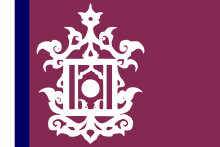 | 1893 | 1899 |
| Jamal ul-Kiram I |  | 1825 | 1839, the progeny of the 1752 Kiram Sinsuat, Kiram Misuari and Kiram Sorronga. |
| Mahakuttah Kiram | 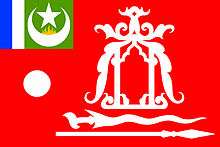 | 1974 | 1986 |
| Muedzul Lail Tan Kiram |  | 1986 | |
Philippines Era
The collection of islands conquered by the Spaniards was named Las islas Filipinas; a name given by Ruy López de Villalobos. It's the exact geographical location on which the modern day Republic of the Philippines based its territory.
Rulers during the Spanish colonization
During the Spanish colonization, Remaining monarchs reign until their kingdoms was absorbed to the new colonial nation of the Philippines through Spanish conquest. Many of these territories are absorbed much later.
- Rajah Colambu – King of Limasawa in 1521, brother of Rajah Siagu of Butuan. He befriended Portuguese explorer Ferdinand Magellan and guided him to Cebu on April 7, 1521.
- Rajah Humabon – King of Cebu who became an ally of Ferdinand Magellan and the Spaniards. Rival of Datu Lapu-Lapu. In 1521, he and his wife were baptized as Christians and given Christian names Carlos and Juana after the Spanish royalty, King Carlos and Queen Juana.
- Sultan Kudarat – Sultan of Maguindanao.
- Lakan Dula or Lakandula – King of Tondo, one of the last princes of Manila.
- Datu Lapu-Lapu – King of Mactan Island. He defeated the Spaniards on April 27, 1521.
- Datu Sikatuna – King of Bohol in 1565. He made a blood compact with Spanish explorer, Miguel López de Legazpi.
- Datu Pagbuaya – King of Bohol. He governed with his brother Datu Dailisan, a settlement along the shorelines between Mansasa, Tagbilaran and Dauis, which was abandoned years before the Spanish colonization due to Portuguese and Ternatean attacks. He founded Dapitan in the northern shore of Mindanao.
- Datu Dailisan – King of Mansasa, Tagbilaran and Dauis and governed their kingdom along with his brother Datu Pagbuaya. His death during one of the Portuguese raids caused the abandonment of the settlement.
- Datu Manooc – Christian name – Pedro Manuel Manooc, son of Datu Pagbuaya who converted to Christianity, defeated the Higaonon tribe in Iligan, Mindanao. He established one of the first Christian settlements in the country.
- Datu Macabulos – King of Pampanga in 1571.
- Rajah Siagu – King of the Manobo in 1521.
- Apo Noan – Chieftain of Mandani (present day Mandaue) in 1521.
- Apo Macarere – Famous Chieftain of the Tagbanwa warrior tribe in Corong Island (Calis).
- Rajah Sulaiman III – One of the last King of Manila, was defeated by Martín de Goiti, a Spanish soldier commissioned by López de Legazpi to Manila.
- Rajah Tupas – King of Cebu, conquered by Miguel López de Legazpi.
- Datu Urduja – Female Leader in Pangasinan.
- Datu Zula – Chieftain of Mactan, Cebu. Rival of Lapu-lapu
- Datu Kalun – Ruler of the Island of the Basilan and the Yakans in Mindanao, converted his line to Christianity
- Datu Sanday – Ruler of Marawi City
- Datu Saiden Borero – King of Antique
- unnamed Datu – King of Taytay Palawan. Mentioned by Pigafetta, chronicler of Magellan. The king, together with his wife were kidnapped by the remnant troops from Magellan's fleet after fleeing Cebu to secure provisions for their crossing to the Moluccas.
- Datu Cabaylo (Cabailo) – The last king of the Kingdom of Taytay
Colonial Governor-Generals Under New Spain (1565–1761)
From 1565 to 1898, the Philippines was under Spanish rule. From 1565–1821, The governor and captain-general was appointed by the Viceroy of New Spain upon recommendation of the Spanish Cortes and governed on behalf of the Monarch of Spain. When there was a vacancy (e.g. death, or during the transitional period between governors), the Real Audiencia in Manila appoints a temporary governor from among its members.
After 1821, the country was no longer under the Viceroyalty of New Spain (present-day Mexico) and administrative affairs formerly handled by New Spain were transferred to Madrid and placed directly under the Spanish Crown.
Ad interim Real Audiencia
| # | Photo | Name | From | Until | Monarch |
|---|---|---|---|---|---|
| 1 | 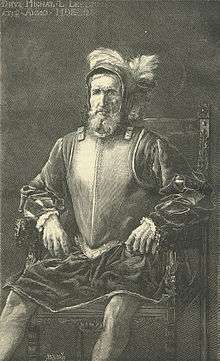 |
Miguel López de Legazpi | April 27, 1565 | August 20, 1572 | 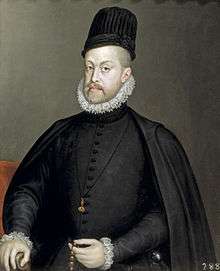 Philip II (25 July 1554 – 13 September 1598) |
| 2 |  |
Guido de Lavezaris | August 20, 1572 | August 25, 1575 | |
| 3 | .svg.png) |
Francisco de Sande | August 25, 1575 | April 1580 | |
| 4 | .svg.png) |
Gonzalo Ronquillo de Peñalosa | April 1580 | March 10, 1583 | |
| 5 | .svg.png) |
Diego Ronquillo | March 10, 1583 | May 16, 1584 | |
| 6 | .svg.png) |
Santiago de Vera | May 16, 1584 | May 1590 | |
| 7 | .svg.png) |
Gómez Pérez Dasmariñas | June 1, 1590 | October 25, 1593 | |
| 8 | .svg.png) |
Pedro de Rojas | October 1593 | December 3, 1593 | |
| 9 | .svg.png) |
Luís Pérez Dasmariñas | December 3, 1593 | July 14, 1596 | |
| 10 | .svg.png) |
Francisco de Tello de Guzmán | July 14, 1596 | May 1602 | |
_-_WGA24408.jpg) Philip III (13 September 1598 – 31 March 1621) | |||||
| 11 | .svg.png) |
Pedro Bravo de Acuña | May 1602 | June 24, 1606 | |
| 12 | .jpg) |
Cristóbal Téllez de Almanza (Real Audiencia) |
June 24, 1606 | June 15, 1608 | |
| 13 | .svg.png) |
Rodrigo de Vivero y Aberrucia | June 15, 1608 | April 1609 | |
| 14 | .svg.png) |
Juan de Silva | April 1609 | April 19, 1616 | |
| 15 | .svg.png) |
Andrés Alcaraz (Real Audiencia) |
April 19, 1616 | July 3, 1618 | |
| 16 | .svg.png) |
Alonso Fajardo de Entenza | July 3, 1618 | July 1624 | |
 Philip IV (31 March 1621 – 17 September 1665) | |||||
| 17 | .svg.png) |
Jeronimo de Silva (Real Audiencia) |
July 1624 | June 1625 | |
| 18 | .svg.png) |
Fernándo de Silva | July 1624 | June 29, 1626 | |
| 19 | .svg.png) |
Juan Niño de Tabora | June 29, 1626 | July 22, 1632 | |
| 20 | .svg.png) |
Lorenzo de Olaza y Lecubarri (Real Audiencia) |
July 22, 1632 | 1633 | |
| 21 | .svg.png) |
Juan Cerezo de Salamanca | August 29, 1633 | June 25, 1635 | |
| 22 |  |
Sebastián Hurtado de Corcuera | June 25, 1635 | August 11, 1644 | |
| 23 | .svg.png) |
Diego Fajardo Chacón | August 11, 1644 | July 25, 1653 | |
| 24 | .svg.png) |
Sabiniano Manrique de Lara | July 25, 1653 | September 8, 1663 | |
| 25 | .svg.png) |
Diego de Salcedo | September 8, 1663 | September 28, 1668 | |
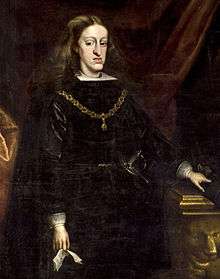 Charles II (17 September 1665 – November 1, 1700) | |||||
| 26 | .svg.png) |
Juan Manuel de la Peña Bonifaz | September 28, 1668 | September 24, 1669 | |
| 27 | .svg.png) |
Manuel de León | September 24, 1669 | September 21, 1677 | |
| 28 | .svg.png) |
Francisco Coloma y Maceda (Real Audiencia) |
April 11, 1677 | September 25, 1677 | |
| 29 | .svg.png) |
Francisco Sotomayor y Mansilla (Real Audiencia) |
September 21, 1677 | September 28, 1678 | |
| 30 | .svg.png) |
Juan de Vargas y Hurtado | September 28, 1678 | August 24, 1684 | |
| 31 | .svg.png) |
Gabriel de Curuzealegui y Arriola | August 24, 1684 | April 1689 | |
| 32 | .svg.png) |
Alonso de Avila Fuertes (Real Audiencia) |
April 1689 | July 1690 | |
| 33 | .svg.png) |
Fausto Cruzat y Gongora | July 25, 1690 | December 8, 1701 | |
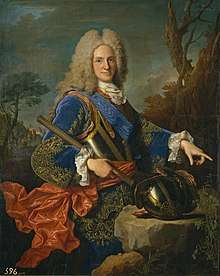 Philip V November 1700 – January 15, 1724 | |||||
| 34 | _Pillars_of_Hercules_Variant.svg.png) |
Domingo Zabálburu de Echevarri | December 8, 1701 | August 25, 1709 | |
| 35 | _Pillars_of_Hercules_Variant.svg.png) |
Martín de Urzúa y Arizmendi, count of Lizárraga | August 25, 1709 | February 4, 1715 | |
| 36 | _Pillars_of_Hercules_Variant.svg.png) |
José Torralba (Real Audiencia) |
February 4, 1715 | August 9, 1717 | |
| 37 | Fernando Manuel de Bustillo Bustamante y Rueda | August 9, 1717 | October 11, 1719 | ||
| - |  |
Archbishop Francisco de la Cuesta (acting) |
October 11, 1719 | August 6, 1721 | |
| 38 | _Pillars_of_Hercules_Variant.svg.png) |
Toribio José Cosio y Campo | August 6, 1721 | August 14, 1729 | |
Louis I (January 15 – August 31, 1724) | |||||
 Philip V (September 6, 1724 – July 9, 1746) | |||||
| 39 | _Pillars_of_Hercules_Variant.svg.png) |
Fernándo Valdés y Tamon | August 14, 1729 | July 1739 | |
| 40 | _Pillars_of_Hercules_Variant.svg.png) |
Gaspar de la Torre | July 1739 | September 21, 1745 | |
| - | _Pillars_of_Hercules_Variant.svg.png) |
Archbishop Juan Arrechederra (acting) |
September 21, 1745 | July 20, 1750 | |
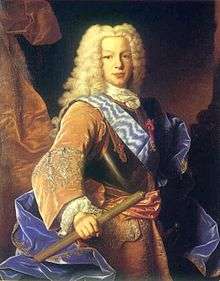 (July 9, 1746 – August 10, 1759) | |||||
| 41 | _Pillars_of_Hercules_Variant.svg.png) |
Francisco José de Ovando, 1st Marquis of Brindisi | July 20, 1750 | July 26, 1754 | |
| 42 | _Pillars_of_Hercules_Variant.svg.png) |
Pedro Manuel de Arandía Santisteban | July 26, 1754 | May 31, 1759 | |
| - | _Pillars_of_Hercules_Variant.svg.png) |
Bishop Miguel Lino de Ezpeleta (acting) |
June 1759 | May 31, 1761 | |
 Charles III (August 10, 1759 – December 14, 1788) | |||||
| - |  |
Archbishop Manuel Rojo del Río y Vieyra (acting) |
July 1761 | October 6, 1762 |
During Revolts against Spain (1660–1661)
| Name | Image | From | Until | Notes |
|---|---|---|---|---|
| Francisco Maniago |  |
1660 | 1661 | a Filipino revolutionary leader who conspired to overthrow Spanish rule in the northern Philippines and establish an independent Kapampangan nation in Pampanga, with him as "King of Pampanga." |
| Name | Image | From | Until | Notes |
|---|---|---|---|---|
| Andres Malong | 1660 | 1661 | a Filipino revolutionary leader who conspired to overthrow Spanish rule in the northern Philippines and establish an independent Pangasinense nation in Pangasinan, with him as "King of Pangasinan." | |
| Name | Image | From | Until | Notes |
|---|---|---|---|---|
| Pedro Almazán | 1661 | 1661 | a Filipino revolutionary leader who conspired to overthrow Spanish rule in the northern Philippines and establish an independent Ilocano nation in Ilocos, with him as "King of Ilocos." | |
British Occupation of Manila (1761–1764)
Great Britain occupied Manila and the naval port of Cavite as part of the Seven Years' War.
| # | Photo | Governor-General | From | Until | Monarch |
|---|---|---|---|---|---|
| 43 | _Pillars_of_Hercules_Variant.svg.png) |
Simón de Anda y Salazar (Provisional Government in Bacolor, Pampanga) |
October 6, 1762 | February 10, 1764 |  Charles III |
| 44 | .svg.png) |
Dawsonne Drake | November 2, 1762 | May 31, 1764 | 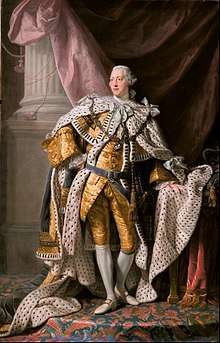 George III |
Independent Ilocos (1762–1763)
| Name | Image | From | Until | Notes |
|---|---|---|---|---|
| Diego Silang | 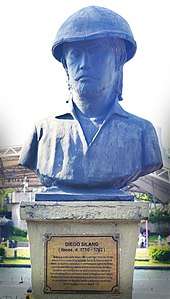 |
1762 | 1763 | a Filipino revolutionary leader who conspired with British forces to overthrow Spanish rule in the northern Philippines and establish an independent Ilocano nation. |
Under New Spain (1764–1821)
| # | Picture | Name | From | Until | Monarch |
|---|---|---|---|---|---|
| 45 | _Pillars_of_Hercules_Variant.svg.png) |
Francisco Javier de la Torre | March 17, 1764 | July 6, 1765 |  Charles III |
| 46 | _Pillars_of_Hercules_Variant.svg.png) |
José Antonio Raón y Gutiérrez | July 6, 1765 | July 1770 | |
| (43) | _Pillars_of_Hercules_Variant.svg.png) |
Simón de Anda y Salazar | July 1770 | October 30, 1776 | |
| 47 | _Pillars_of_Hercules_Variant.svg.png) |
Pedro de Sarrio | October 30, 1776 | July 1778 | |
| 48 |  |
José Basco y Vargas | July 1778 | September 22, 1787 | |
| (47) | _Pillars_of_Hercules_Variant.svg.png) |
Pedro de Sarrio | September 22, 1787 | July 1, 1788 | |
| 49 | 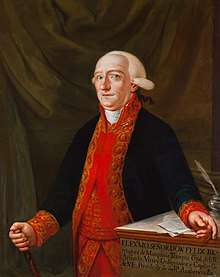 |
Félix Berenguer de Marquina | July 1, 1788 | September 1, 1793 | |
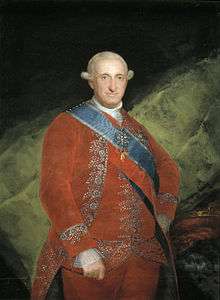 Charles IV | |||||
| 50 | _Pillars_of_Hercules_Variant.svg.png) |
Rafael María de Aguilar y Ponce de León | September 1, 1793 | August 7, 1806 | |
| 51 | _Pillars_of_Hercules_Variant.svg.png) |
Mariano Fernández de Folgueras | August 7, 1806 | March 4, 1810 | |
_by_Goya.jpg) Ferdinand VII | |||||
 Joseph Bonaparte | |||||
| 52 | _Pillars_of_Hercules_Variant.svg.png) |
Manuel Gonzalez de Aguilar | March 4, 1810 | September 4, 1813 | |
| 53 | _Pillars_of_Hercules_Variant.svg.png) |
José Gardoqui Jaraveitia | September 4, 1813 | December 10, 1816 | |
_by_Goya.jpg) Ferdinand VII | |||||
| (51) | _Pillars_of_Hercules_Variant.svg.png) |
Mariano Fernández de Folgueras | December 10, 1816 | September 15, 1821 |
Emperor
| Name | Image | From | Until | Notes |
|---|---|---|---|---|
| Andrés Novales | 1823 | 1823 | His discontentment with the treatment of creole soldiers led him to start a revolt in 1823 that inspired even the ranks of José Rizal. He successfully captured Intramuros and was proclaimed Emperor of the Philippines by his followers. However, he was defeated within the day by Spanish reinforcements from Pampanga.[11] | |
Direct Spanish control (1821–1898)
After the 1821 Mexican War of Independence, Mexico became independent and was no longer part of the Spanish Empire. The Viceroyalty of New Spain ceased to exist. The Philippines, as a result, was directly governed from Madrid, under the Crown.
| # | Picture | Name | From | Until | Monarch |
|---|---|---|---|---|---|
| (51) | _Pillars_of_Hercules_Variant.svg.png) |
Mariano Fernández de Folgueras | September 16, 1821 | October 30, 1822 |  Ferdinand VII |
| 54 | _Pillars_of_Hercules_Variant.svg.png) |
Juan Antonio Martínez | October 30, 1822 | October 14, 1825 | |
| 55 | _Pillars_of_Hercules_Variant.svg.png) |
Mariano Ricafort Palacín y Abarca | October 14, 1825 | December 23, 1830 | |
| 56 | 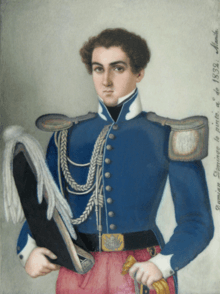 |
Pasqual Enrile y Alcedo | December 23, 1830 | March 1, 1835 | |
 Isabella II | |||||
| 57 | _Pillars_of_Hercules_Variant.svg.png) |
Gabriel de Torres | March 1, 1835 | April 23, 1835 | |
| 58 | _Pillars_of_Hercules_Variant.svg.png) |
Joaquín de Crámer | April 23, 1835 | September 9, 1835 | |
| 59 | _Pillars_of_Hercules_Variant.svg.png) |
Pedro Antonio Salazar Castillo y Varona | September 9, 1835 | August 27, 1837 | |
| 60 | _Pillars_of_Hercules_Variant.svg.png) |
Andrés García Camba | August 27, 1837 | December 29, 1838 | |
| 61 | _Pillars_of_Hercules_Variant.svg.png) |
Luis Lardizábal | December 29, 1838 | February 14, 1841 | |
| 62 | 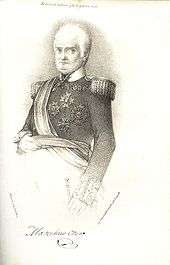 |
Marcelino de Oraá Lecumberri | February 14, 1841 | June 17, 1843 | |
| 63 | _Pillars_of_Hercules_Variant.svg.png) |
Francisco de Paula Alcalá de la Torre | June 17, 1843 | July 16, 1844 | |
| 64 | .jpg) |
Narciso Clavería, 1st Count of Manila | July 16, 1844 | December 26, 1849 | |
| 65 | _Pillars_of_Hercules_Variant.svg.png) |
Antonio María Blanco | December 26, 1849 | July 29, 1850 | |
| 66 |  |
Antonio de Urbistondo y Eguía | July 29, 1850 | December 20, 1853 | |
| 67 | _Pillars_of_Hercules_Variant.svg.png) |
Ramón Montero y Blandino | December 20, 1853 | February 2, 1854 | |
| 68 | 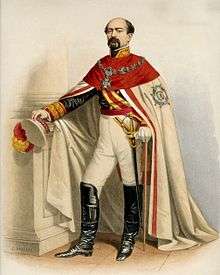 |
Manuel Pavía, 1st Marquis of Novaliches | February 2, 1854 | October 28, 1854 | |
| (67) | _Pillars_of_Hercules_Variant.svg.png) |
Ramón Montero y Blandino | October 28, 1854 | November 20, 1854 | |
| 69 | _Pillars_of_Hercules_Variant.svg.png) |
Manuel Crespo y Cebrían | November 20, 1854 | December 5, 1856 | |
| (67) | _Pillars_of_Hercules_Variant.svg.png) |
Ramón Montero y Blandino | December 5, 1856 | March 9, 1857 | |
| 70 |  |
Fernándo Norzagaray y Escudero | March 9, 1857 | January 12, 1860 | |
| 71 | _Pillars_of_Hercules_Variant.svg.png) |
Ramón María Solano y Llanderal | January 12, 1860 | August 29, 1860 | |
| 72 | _Pillars_of_Hercules_Variant.svg.png) |
Juan Herrera Dávila | August 29, 1860 | February 2, 1861 | |
| 73 | _Pillars_of_Hercules_Variant.svg.png) |
José Lemery e Ibarrola Ney y González | February 2, 1861 | July 7, 1862 | |
| 74 | _Pillars_of_Hercules_Variant.svg.png) |
Salvador Valdés | July 7, 1862 | July 9, 1862 | |
| 75 | _Pillars_of_Hercules_Variant.svg.png) |
Rafaél de Echagüe y Bermingham | July 9, 1862 | March 24, 1865 | |
| 76 | _Pillars_of_Hercules_Variant.svg.png) |
Joaquín del Solar e Ibáñez | March 24, 1865 | April 25, 1865 | |
| 77 | _Pillars_of_Hercules_Variant.svg.png) |
Juan de Lara e Irigoyen | April 25, 1865 | July 13, 1866 | |
| 78 | _Pillars_of_Hercules_Variant.svg.png) |
José Laureano de Sanz y Posse | July 13, 1866 | September 21, 1866 | |
| 79 | _Pillars_of_Hercules_Variant.svg.png) |
Juan Antonio Osorio | September 21, 1866 | September 27, 1866 | |
| (76) | _Pillars_of_Hercules_Variant.svg.png) |
Joaquín del Solar e Ibáñez | September 27, 1866 | October 26, 1866 | |
| 80 | 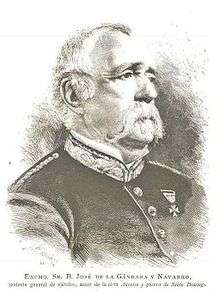 |
José de la Gándara y Navarro | October 26, 1866 | June 7, 1869 | |
| No Monarch | |||||
| 81 | .svg.png) |
Manuel Maldonado | June 7, 1869 | June 23, 1869 | |
| 82 |  |
Carlos María de la Torre y Navacerrada | June 23, 1869 | April 4, 1871 | |
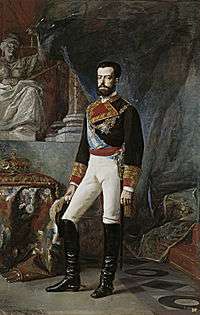 Amadeo I (December 16, 1870 – February 11, 1873) | |||||
| 83 | _Pillars_of_Hercules_Variant.svg.png) |
Rafael de Izquierdo y Gutíerrez | April 4, 1871 | January 8, 1873 | |
| 84 | _Pillars_of_Hercules_Variant.svg.png) |
Manuel MacCrohon | January 8, 1873 | January 24, 1873 | |
| 85 | .svg.png) |
Juan Alaminos y Vivar | January 24, 1873 | March 17, 1874 | |
| No Monarch | |||||
| - | .svg.png) |
Manuel Blanco Valderrama (acting) |
March 17, 1874 | June 18, 1874 | |
| 86 |  |
José Malcampo y Monje | June 18, 1874 | February 28, 1877 | |
.jpg) Alfonso XII (December 29, 1874 – November 25, 1885) | |||||
| 87 | _Pillars_of_Hercules_Variant.svg.png) |
Domingo Moriones y Murillo | February 28, 1877 | March 20, 1880 | |
| 88 | _Pillars_of_Hercules_Variant.svg.png) |
Rafael Rodríguez Arias | March 20, 1880 | April 15, 1880 | |
| 89 |  |
Fernando Primo de Rivera, 1st Marquis of Estella | April 15, 1880 | March 10, 1883 | |
| - | _Pillars_of_Hercules_Variant.svg.png) |
Emilio Molíns 1st term, (acting) |
March 10, 1883 | April 7, 1883 | |
| 90 | 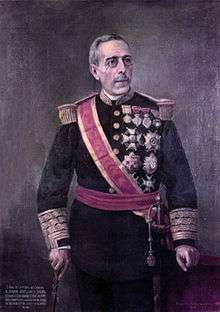 |
Joaquín Jovellar | April 7, 1883 | April 1, 1885 | |
| - | _Pillars_of_Hercules_Variant.svg.png) |
Emilio Molíns 2nd term, (acting) |
April 1, 1885 | April 4, 1885 | |
| 91 | _Pillars_of_Hercules_Variant.svg.png) |
Emilio Terrero y Perinat | April 4, 1885 | April 25, 1888 | |
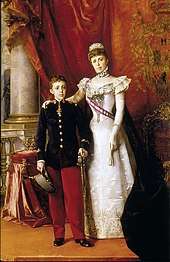 Alfonso XIII (May 17, 1886) | |||||
| - | _Pillars_of_Hercules_Variant.svg.png) |
Antonio Moltó (acting) |
April 25, 1888 | June 4, 1888 | |
| - | _Pillars_of_Hercules_Variant.svg.png) |
Federico Lobatón (acting) |
June 4, 1888 | June 5, 1888 | |
| 92 |  |
Valeriano Wéyler | June 5, 1888 | November 17, 1891 | |
| 93 |  |
Eulogio Despujol | November 17, 1891 | March 1, 1893 | |
| - | _Pillars_of_Hercules_Variant.svg.png) |
Federico Ochando (acting) |
March 1, 1893 | May 4, 1893 | |
| 94 |  |
Ramón Blanco, 1st Marquis of Peña Plata | May 4, 1893 | December 13, 1896 | |
| - | 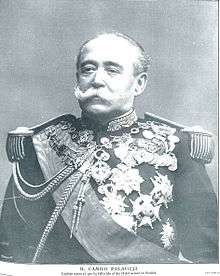 |
Camilo de Polavieja, 1st Marquis of Polavieja (acting) |
December 13, 1896 | April 15, 1897 | |
| - | _Pillars_of_Hercules_Variant.svg.png) |
José de Lachambre (acting) |
April 15, 1897 | April 23, 1897 | |
| 95 |  |
Fernando Primo de Rivera, 1st Marquis of Estella | April 23, 1897 | April 11, 1898 | |
| 96 | 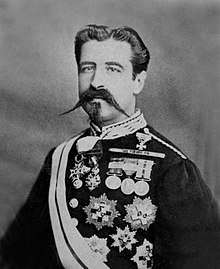 |
Basilio Augustín[12] | April 11, 1898 | July 24, 1898 | |
| - | _Pillars_of_Hercules_Variant.svg.png) |
Fermín Jáudenes[12] (acting) |
July 24, 1898 | August 13, 1898 | |
| - | _Pillars_of_Hercules_Variant.svg.png) |
Francisco Rizzo[12] (acting) |
August 13, 1898 | September 1898 | |
| - | .jpg) |
Diego de los Rios[12] (acting) |
September 1898 | June 3, 1899 |
Revolutionary Republics and States
The Ruling Leaders during Philippine Revolution
| President | Image | From | Until |
|---|---|---|---|
| Andres Bonifacio | 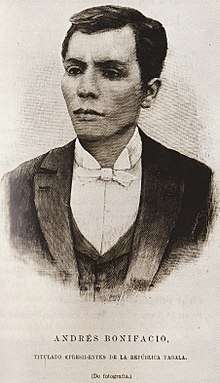 | 1896 | 1897 |
| President | Image | From | Until |
|---|---|---|---|
| Emilio Aguinaldo | .jpg) | 1897 | December 15, 1897 |
| President | Image | From | Until |
|---|---|---|---|
| Emilio Aguinaldo | .jpg) | 1897 | 1901 |
| Miguel Malvar | 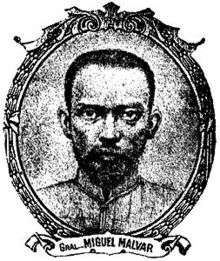 | 1901 | 1902 |
| President | Image | From | Until |
|---|---|---|---|
| Macario Sakay | 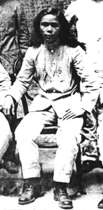 | 1902 | 1906 |
| President | Image | From | Until |
|---|---|---|---|
| Vicente Alvarez | 1899 | 1899 | |
| Isidro Midel | 1899 | 1901 | |
| Mariano Arquiza | 1901 | 1903 |
| President | Image | From | Until |
|---|---|---|---|
| Aniceto Lacson |  | 1898 | 1899 |
| Melecio Severino | 1899 | 1901 | |
United States Military Government (1898–1901)
The American military government was established following the defeat of Spain in the Spanish–American War. During the transition period, executive authority in all civil affairs in the Philippine government was exercised by the military governor.
| # | Picture | Name | From | Until | President |
|---|---|---|---|---|---|
| 1 | 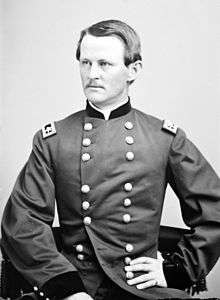 |
Wesley Merritt | August 14, 1898[13] | August 30, 1898[14] | 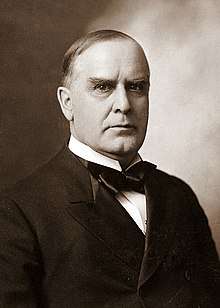 William McKinley |
| 2 |  |
Elwell S. Otis | August 28, 1898 | May 5, 1900 | |
| 3 | 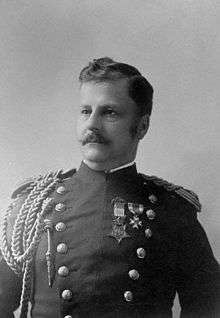 |
Arthur MacArthur, Jr. | May 5, 1900 | July 4, 1901 | |
| 4 | 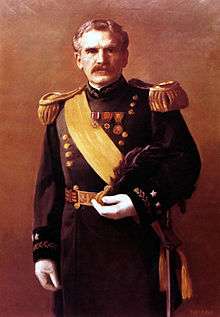 |
Adna Chaffee[15] | July 4, 1901 | July 4, 1902 |
Insular Government (1901–1935)
On July 4, 1901, executive authority over the islands was transferred to the president of the Second Philippine Commission who had the title of Civil Governor, a position appointed by the President of the United States and approved by the United States Senate. For the first year, a Military Governor, Adna Chaffee, ruled parts of the country still resisting the American rule, concurrent with civil governor, William Howard Taft.[16] Disagreements between the two were not uncommon.[17] The following year, on July 4, 1902, Taft became the sole executive authority.[15] Chaffee remained as commander of Philippine Division until September 30, 1902.[18]
The title was changed to Governor General in 1905 by an act of Congress (Public 43 – February 6, 1905).[15] The term "insular" (from insulam, the Latin word for island)[19] refers to U.S. island territories that are not incorporated into either a state or a federal district. All insular areas was under the authority of the U.S. Bureau of Insular Affairs, a division of the US War Department.[20][21]
| # | Picture | Name | From | Until | President |
|---|---|---|---|---|---|
| 1 | 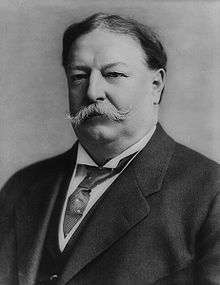 |
William Howard Taft | July 4, 1901 | February 1, 1904 |  William McKinley To September 1901 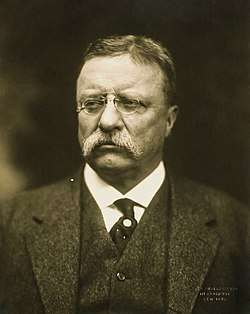 Theodore Roosevelt From September 1901 |
| 2 |  |
Luke Edward Wright | February 1, 1904 | November 3, 1905 |  Theodore Roosevelt |
| 3 |  |
Henry Clay Ide | November 3, 1905 | September 19, 1906 | |
| 4 |  |
James Francis Smith | September 20, 1906 | November 11, 1909 | |
| 5 | 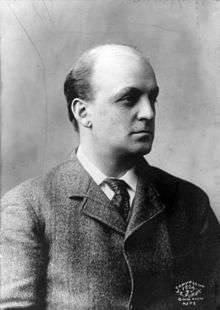 |
William Cameron Forbes | November 11, 1909 | September 1, 1913 |  William Howard Taft |
| – | .jpg) |
Newton W. Gilbert (Acting Governor-General) |
September 1, 1913 | October 6, 1913 | 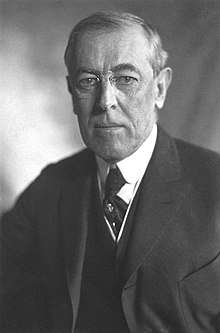 Woodrow Wilson |
| 6 |  |
Francis Burton Harrison | October 6, 1913 | March 5, 1921 | |
| – | .jpg) |
Charles Yeater (Acting Governor-General) |
March 5, 1921 | October 14, 1921 | 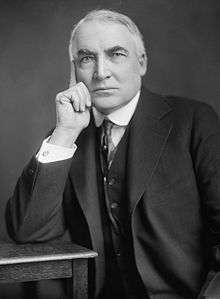 Warren G. Harding To September 1923 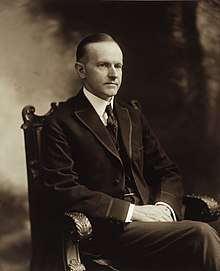 Calvin Coolidge |
| 7 |  |
Leonard Wood | October 14, 1921 | August 7, 1927 | |
| – | .jpg) |
Eugene Allen Gilmore (Acting Governor-General) |
August 7, 1927 | December 27, 1927 |  Calvin Coolidge |
| 8 |  |
Henry L. Stimson | December 27, 1927 | February 23, 1929 | |
| – | .jpg) |
Eugene Allen Gilmore (Acting Governor-General) |
February 23, 1929 | July 8, 1929 | 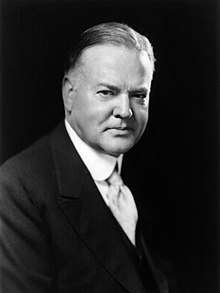 Herbert Hoover |
| 9 | 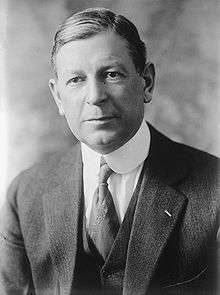 |
Dwight F. Davis | July 8, 1929 | January 9, 1932 | |
| – | .jpg) |
George C. Butte (Acting Governor-General) |
January 9, 1932 | February 29, 1932 | |
| 10 |  |
Theodore Roosevelt, Jr. | February 29, 1932 | July 15, 1933 | |
| 11 | 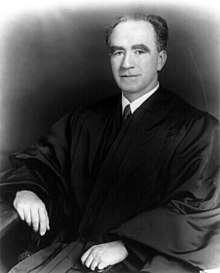 |
Frank Murphy | July 15, 1933 | November 14, 1935 Became High Commissioner to the Philippines |
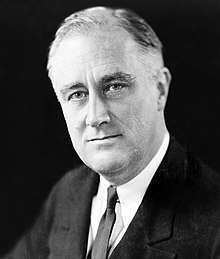 Franklin D. Roosevelt |
On November 15, 1935, the Commonwealth of the Philippines was inaugurated as a transitional government to prepare the country for independence. The office of President of the Philippine Commonwealth replaced the Governor-General as the country's chief executive. The Governor-General became the High Commissioner of the Philippines with Frank Murphy, the last governor-general, as the first high commissioner. The High Commissioner exercised no executive power but rather represented the colonial power, the United States Government, in the Philippines. The high commissioner moved from Malacañang Palace to the newly built High Commissioner's Residence, now the Embassy of the United States in Manila.
After the Philippine independence on July 4, 1946, the last High Commissioner, Paul McNutt, became the first United States Ambassador to the Philippines.
Philippine Commonwealth (1935–1946)
The Commonwealth was inaugurated on November 15, 1935 at Manila, and ended upon independence on July 4, 1946.
| No. overall [note 2] |
No. in era |
Portrait | Name (Birth–Death) |
Prior office | Took office | Left office | Party | Term [note 3] |
Vice President | Refs. | |
|---|---|---|---|---|---|---|---|---|---|---|---|
| 2 | 1 | 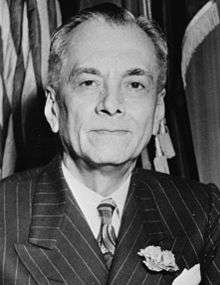 |
Manuel L. Quezon 1878–1944 (Lived: 65 years) |
Senator from the Fifth Senatorial District and 1st President of the Senate (1916–1935) |
15 Nov 1935 [note 4] |
1 Aug 1944 [note 5] [note 6] |
Nacionalista | (1935) 2 (1935) |
Sergio Osmeña | [27] [28] [29] [26] | |
| (1941) 3 (1941) (1944) | |||||||||||
| 4 [note 7] |
2 |  |
Sergio Osmeña 1878–1961 (Lived: 83 years) |
1st Vice President of the Philippines (1935–1944) |
1 Aug 1944 | 28 May 1946 [note 8] [note 9] |
Nacionalista | Vacant [note 10] |
[32] [33] [26] | ||
| 5 | 3 | 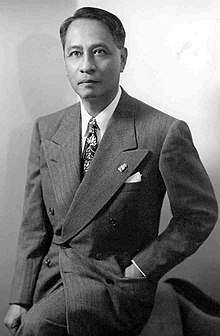 |
Manuel Roxas 1892–1948 (Lived: 56 years) |
Senator from Capiz and 2nd President of the Senate (1945–1946) |
28 May 1946 | 15 Apr 1948 | Liberal [note 11] |
(1946) 5 (1946) [note 7] |
Elpidio Quirino | [36] [37] [34] | |
Japanese Military Governors (1942–1945)
In December 1941, the Commonwealth of the Philippines was invaded by Japan as part of World War II. The next year, the Empire of Japan sent a military governor to control the country during wartime, followed by the formal establishment of the puppet second republic.[38]
| # | Picture | Name | From | Until | Monarch |
|---|---|---|---|---|---|
| 1 | 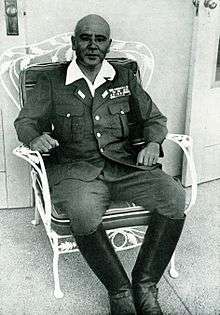 |
Masaharu Homma | January 3, 1942 | June 8, 1942 | 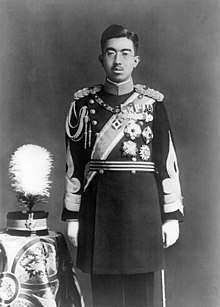 Emperor Hirohito |
| 2 | 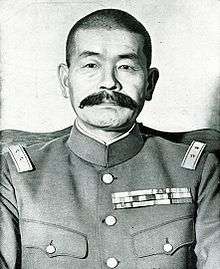 |
Shizuichi Tanaka | June 8, 1942 | May 28, 1943 | |
| 3 | 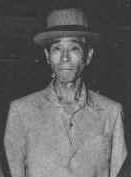 |
Shigenori Kuroda | May 28, 1943 | September 26, 1944 | |
| 4 |  |
Tomoyuki Yamashita | September 26, 1944 | September 2, 1945 |
Second Philippine Republic (1943–1945)
The Second Republic was inaugurated on October 14, 1943 in Manila, and ended when President Jose P. Laurel dissolved the republic on August 17, 1945, in Tokyo.
| No. overall [note 2] |
No. in era |
Portrait | Name (Birth–Death) |
Prior office | Took office | Left office | Party | Term [note 3] |
Vice President | Refs. | |
|---|---|---|---|---|---|---|---|---|---|---|---|
| 3 | 1 | .jpg) |
José P. Laurel 1891–1959 (Lived: 68 years) |
10th & 17th Minister of the Interior (1922–1923 & 1942–1943) |
14 Oct 1943 [note 12] |
17 Aug 1945 [note 13]</ref> [note 14] |
KALIBAPI [note 15] |
(1943) 4 (1943) |
None [note 16] |
[44] [48] | |
Third Philippine Republic (1946–1972)
The Third Republic started when independence was granted by the Americans on July 4, 1946, and ended upon the imposition of martial law by President Ferdinand Marcos on September 21, 1972.
| No. overall [note 2] |
No. in era |
Portrait | Name (Birth–Death) |
Prior office | Took office | Left office | Party | Term [note 3] |
Vice President | Refs. | |
|---|---|---|---|---|---|---|---|---|---|---|---|
| 5 | 1 |  |
Manuel Roxas 1892–1948 (Lived: 56 years) |
Senator from Capiz and 2nd President of the Senate (1945–1946) |
28 May 1946 | 15 Apr 1948 [note 18] |
Liberal [note 11] |
(1946) 5 (1946) (1948) |
Elpidio Quirino | [36] [37] [34] | |
| Vacant April 15–17, 1948 |
[51] | ||||||||||
| 6 | 2 |  |
Elpidio Quirino 1890–1956 (Lived: 65 years) |
2nd Vice President of the Philippines (1946–1948) |
17 Apr 1948 | 30 Dec 1953 [note 8] |
Liberal [note 19] |
Vacant [note 10] 17 Apr 1948–30 Dec 1949 |
[53] [54] [34] [52] | ||
| (1949) 6 (1949) |
Fernando Lopez 30 Dec 1949–30 Dec 1953 | ||||||||||
| 7 | 3 | 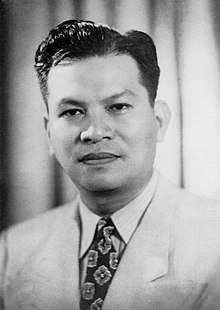 |
Ramon Magsaysay 1907–1957 (Lived: 49 years) |
7th Secretary of National Defense (1950–1953) |
30 Dec 1953 | 17 Mar 1957 [note 20] |
Nacionalista | (1953) 7 (1953) (1957) |
Carlos P. Garcia | [57] [58] [59] | |
| 8 | 4 | 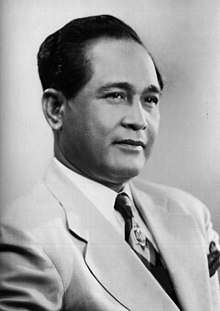 |
Carlos P. Garcia 1896–1971 (Lived: 74 years) |
4th Vice President of the Philippines (1953–1957) |
18 Mar 1957 | 30 Dec 1961 [note 8] |
Nacionalista | Vacant [note 10] Mar 18– 30 Dec 1957 |
[60] [61] [59] [62] | ||
| (1957) 8 (1957) |
Diosdado Macapagal 30 Dec 1957–30 Dec 1961 | ||||||||||
| 9 | 5 | 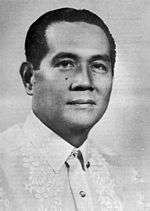 |
Diosdado Macapagal 1910–1997 (Lived: 86 years) |
5th Vice President of the Philippines (1957–1961) |
30 Dec 1961 | 30 Dec 1965 [note 8] |
Liberal | (1961) 9 (1961) |
Emmanuel Pelaez | [63] [64] [65] | |
| 10 | 6 | .jpg) |
Ferdinand Marcos 1917–1989 (Lived: 72 years) |
Senator from Ilocos Norte (1959–1965) and 11th President of the Senate (1963–1965) |
30 Dec 1965 | 25 Feb 1986 [note 8] [note 21]</ref> |
Nacionalista | (1965) 10 (1965) |
Fernando Lopez 30 Dec 1965–23 Sep 1972 [note 22] |
[69] [70] [71] [72] [73] | |
| (1969) 11 [note 23] [note 24]</ref> (1969) | |||||||||||
| None [note 25] 23 Sep 1972–25 Feb 1986 | |||||||||||
| KBL | (1981) 12 [note 26] (1981) | ||||||||||
Martial law and the Fourth Philippine Republic (1972–1987)
President Ferdinand Marcos ruled by decree when he declared martial law on September 21, 1972. He inaugurated the "New Society" after a new constitution was ratified on January 17, 1973. He declared the Fourth Republic on January 17, 1981, after martial law was lifted.
| No. overall [note 2] |
No. in era |
Portrait | Name (Birth–Death) |
Prior office | Took office | Left office | Party | Term [note 3] |
Vice President | Refs. | |
|---|---|---|---|---|---|---|---|---|---|---|---|
| 10 | 1 | .jpg) |
Ferdinand Marcos 1917–1989 (Lived: 72 years) |
Senator from Ilocos Norte (1959–1965) and 11th President of the Senate (1963–1965) |
30 Dec 1965 | 25 Feb 1986 [note 8] [note 21] |
Nacionalista | (1965) 10 (1965) |
Fernando Lopez 30 Dec 1965–23 Sep 1972 [note 22] |
[69] [70] [71] [72] [73] | |
| (1969) 11 [note 23] [note 24] (1969) | |||||||||||
| None [note 25] 23 Sep 1972–25 Feb 1986 | |||||||||||
| KBL | (1981) 12 [note 26] (1981) | ||||||||||
| 11 | 2 | 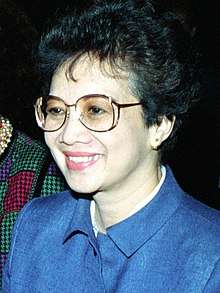 |
Corazon Aquino 1933–2009 (Lived: 76 years) |
none (No prior elected office) |
25 Feb 1986 [note 28] |
30 Jun 1992 | UNIDO | (1986) 13 (1986) |
Salvador Laurel | [76] [77] [66] | |
Fifth Philippine Republic (1987–Present)
President Corazon Aquino inaugurated the Fifth Republic after the present constitution was ratified. The plebiscite took place on February 2, 1987.
| No. overall [note 2] |
No. in era |
Portrait | Name (Birth–Death) |
Prior office | Took office | Left office | Party | Term [note 3] |
Vice President | Refs. | |
|---|---|---|---|---|---|---|---|---|---|---|---|
| 11 | 1 |  |
Corazon Aquino 1933–2009 (Lived: 76 years) |
none (No prior elected office) |
25 Feb 1986 [note 28] |
30 Jun 1992 | UNIDO | (1986) 13 (1986) |
Salvador Laurel | [76] [77] [66] | |
| 12 | 2 |  |
Fidel Ramos Born 1928 (92 years old) |
18th Secretary of National Defense (1988–1991) |
30 Jun 1992 | 30 Jun 1998 | Lakas–NUCD | (1992) 14 (1992) |
Joseph Estrada | [79] [80] [81] | |
| 13 | 3 | .jpg) |
Joseph Estrada Born 1937 (83 years old) |
9th Vice President of the Philippines (1992–1998) |
30 Jun 1998 | 20 Jan 2001 [note 30] [note 14] |
LAMMP | (1998) 15 (1998) (2001) |
Gloria Macapagal Arroyo | [83] [84] [85] | |
| 14 | 4 | 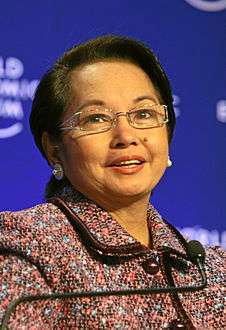 |
Gloria Macapagal Arroyo Born 1947 (73 years old) |
10th Vice President of the Philippines (1998–2001) |
20 Jan 2001 | 30 Jun 2010 | Lakas–NUCD–UMDP Lakas–CMD |
Vacant [note 10] Jan 20– 7 Feb 2001 |
[86] [87] [85] [88] | ||
| Teofisto Guingona Jr. 7 Feb 2001–30 Jun 2004 | |||||||||||
| Lakas–CMD Lakas Kampi CMD |
(2004) 16 (2004) |
Noli de Castro [note 31] 30 Jun 2004–30 Jun 2010 | |||||||||
| 15 | 5 | 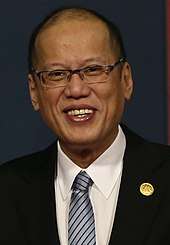 |
Benigno Aquino III Born 1960 (60 years old) |
Senator from Tarlac (2007–2010) |
30 Jun 2010 | 30 Jun 2016 | Liberal | (2010) 17 (2010) |
Jejomar Binay | [89] [90] [91] | |
| 16 | 6 | .jpg) |
Rodrigo Duterte Born 1945 (75 years old) |
Mayor of Davao City (1988–1998; 2001–2010; & 2013–2016) |
30 Jun 2016 | Incumbent (Term ends on June 30, 2022) |
PDP–Laban | (2016) 18 (2016) |
Leni Robredo | [92] | |
See also
- President of the Philippines
- Governor-General of the Philippines
- Filipino styles and honorifics
- Heads of state and government of the Philippines
- First Lady or First Gentleman of the Philippines
- List of ancient Philippine consorts
- List of Presidents of the Philippines
- List of Unofficial Presidents of the Philippines
- Vice President of the Philippines
- List of Vice Presidents of the Philippines
- Prime Minister of the Philippines (now defunct)
- Seal of the President of the Philippines
- List of current heads of state and government
Notes
- The term "Sultana" is used by Odal-Devora in her essay The River Dwellers (2000, page 47), saying "This Prince Bagtas, a grandson of Sultana Kalangitan, the Lady of Pasig, was also said to have ruled the Kingdom of Namayan or Sapa, in the present Sta Ana-Mandaluyong-San Juan- Makati Area. This would explain the Pasig-Sta Ana-Tondo-Bulacan-Pampanga-Batangas interconnections of the Tagalog ruling elites."
- Term began with the formal establishment of the Philippine Commonwealth.[23][subnote 1]
- Died, in office, of tuberculosis in Saranac Lake, New York.[24]
- Term was originally until 15 Nov 1943, due to constitutional limitations as provided by the 1940 amendment of the 1935 Constitution, which shortened the terms of the president and the vice president from six to four years but allowed re-election.[subnote 2] Quezon was not intended to serve the full four years of the second term he won in the 1941 election because a ten-year presidency would have been considered excessive. In 1943, however, due to World War II, he and Vice President Osmeña, who was also re-elected, had to take an emergency oath of office, extending their tenure.[25][26]
- See § 1943–45: Second Republic.
- Unseated (lost re-election).[subnote 2]
- Sought an election for a full term, but was unsuccessful.
- Prior to the ratification of the 1987 Constitution, there was no mechanism by which a vacancy in the vice presidency could be filled.[30][31] Gloria Macapagal Arroyo was the first president to fill such a vacancy under the provisions of the Constitution when she appointed Teofisto Guingona Jr.
- The Liberal Party was not yet a party in itself at the time, but only a wing of the Nacionalista Party.[34] It split and became a separate party by 1947.[35]
- Term began with the establishment of Japan's puppet Second Republic after it occupied the Philippines during World War II.[39][40] The Commonwealth continued its existence as a government in exile in Australia and the United States.[23][41] The Philippines had two concurrent presidents by this time:[25] a de jure (the Commonwealth president) and a de facto (Laurel).[42] Because of his status, he was not considered a legitimate president by the government succeeding the second republic until the 1960s.[43]
- Term ended when he dissolved the Second Republic in the wake of Japan's surrender to the Allies two days prior.[43][40][subnote 3] The Commonwealth was re-established in the Philippines,[39] with Sergio Osmeña as the fourth president.[25][subnote 4]
- Previously affiliated with the Nacionalista Party,[44] but was elected by the National Assembly under the Japanese-organized KALIBAPI, a "non-political service organization" as it described itself.[45] All pre-war parties were replaced by the KALIBAPI.[39][43]
- The 1943 Constitution did not provide for a vice president.[46][47]
- The Third Republic began when the Philippine Commonwealth ended on July 4, 1946.[25][49]
- Died, in office, of a heart attack in Clark Air Base, Pampanga.[50]
- The Liberal Party was split into two opposing wings for the 1949 election: the Avelino wing, led by presidential aspirant José Avelino, and the Quirino wing.[52]
- Died, in office, in a plane crash in Mount Manunggal, Cebu.[55][56]
- Deposed in the People Power Revolution.[subnote 5][66] The events led to the People Power Revolution on February 22–25, which forced Marcos to leave to exile in Hawaii and installed Aquino to the office.[67][68][66]
- Term ended upon Marcos' declaration of martial law.[46][subnote 6][subnote 7]
- Imposed martial law, as a self-coup, on September 23, 1972, through Proclamation No. 1081, shortly before the end of his second and final term in 1973.[subnote 6] General Order No. 1, which detailed the transfer of all powers to the president, was also issued, enabling Marcos to rule by decree.[74]
- Served concurrently as prime minister from June 12, 1978 to June 30, 1981.[69][subnote 7] the vice presidency was abolished and the presidential succession provision was devolved to the prime minister.[46]
- The 1973 Constitution was amended through a plebiscite held on January 27, 1984 to re-establish the vice presidency.[46][75][subnote 7]
- The 1973 Constitution, as amended in 1981, did not place restrictions on re-election.[subnote 2]
- Martial law was lifted by Ferdinand Marcos on January 17, 1981, through Proclamation No. 2045,[74] marking the beginning of the Fourth Republic.[49]
- Assumed presidency by claiming victory in the disputed 1986 snap election.[subnote 5]
- Corazon Aquino promulgated a provisional constitution called the 1986 Freedom Constitution on March 25, 1986.[78] It remained in effect until it was supplanted by the current constitution on February 2, 19 87,[78] which ushered the Fifth Republic.[25]
- The Supreme Court declared Estrada had resigned and thus vacate the office of the president following the Second EDSA Revolution.[82]
- Allied with the Koalisyon ng Katapatan at Karanasan sa Kinabukasan (Coalition of Truth and Experience for Tomorrow).[88]
Subnotes
- The Second Republic was later declared by the Supreme Court of the Philippines as a de facto, illegitimate government on September 17, 1945. Its laws were considered null and void; despite this, Laurel was included in the official roster of Philippine presidents in the 1960s.
- The Commonwealth had already been temporarily restored in Tacloban on October 23, 1944, during the Battle of Leyte, before it was proclaimed "reestablished as provided by law" on February 27, 1945.<ref>MacArthur, Douglas (February 27, 1945). "Speech of General Douglas MacArthur upon turning over to President Sergio Osmena the full powers and responsibilities of the Commonwealth Government under the Constitution". Official Gazette. Presidential Communications Development and Strategic Planning Office. Retrieved July 24, 2016.
- Ferdinand Marcos and Corazon Aquino both took their oath of office on February 25, 1986. In effect, the Philippines again had two simultaneous presidents, albeit for nine hours only. Marcos was proclaimed on February 15 the winner of the widely denounced February 7 snap election, which he called after opposition leader Benigno Aquino Jr., his chief rival and Corazon's husband, was assassinated in 1983. However, in a separate NAMFREL tally dated February 16, Aquino was found the actual duly-elected president.<ref>"1986 Tally Board". National Citizens' Movement for Free Elections. February 16, 1986. Retrieved July 9, 2016.
- Accounts differ on when martial law was officially established. While sources such as Raymond Bonner have written that Proclamation No. 1081 was signed on September 23, 1972, Primitivo Mijares, a former journalist for Marcos, and the Bangkok Post stated that it was on September 17, only postdated to September 21 because of Marcos' numerological beliefs that were related to the number seven. Marcos claimed to have signed it on September 21, and as of 9 p.m. Philippine Standard Time (UTC+08:00) on September 22, the country was under martial law. He formally announced it in a live television and radio broadcast on September 23. The official date when martial law was set was on September 21 (because it was a date that was divisible by seven), but September 23 is generally considered the correct date because it was when the nation was informed and thus the proclamation was put into full effect.
- On January 17, 1973, while martial law was still in effect, the 1973 Constitution was ratified, which suspended the 1935 Constitution and ended the Third Republic. What Marcos called a New Society (Bagong Lipunan) began, introducing a parliamentary form of government;<ref>Sicat, Gerardo P. (September 23, 2015). "Marcos and his failure to provide for an orderly political succession". The Philippine Star. Retrieved July 9, 2016.
The transitional nature of the political system according to the 1973 Constitution was left undefined in view of the martial law government. This constitution adopted a British-style parliamentary system.
References
- Huerta, Felix, de (1865). Estado Geografico, Topografico, Estadistico, Historico-Religioso de la Santa y Apostolica Provincia de San Gregorio Magno. Binondo: Imprenta de M. Sanchez y Compañia.
- Scott, William Henry (1994). Barangay: Sixteenth Century Philippine Culture and Society. Quezon City: Ateneo de Manila University Press. ISBN 971-550-135-4.
- Odal-Devora, Grace P. (2000). "The River Dwellers". In Alejandro, Reynaldo Gamboa (ed.). Pasig: River of Life. Water Series Trilogy. Unilever Philippines. ISBN 978-9719227205.
- Joaquin, Nick (1990). Manila, My Manila: A History for the Young. City of Manila: Anvil Publishing, Inc. ISBN 978-971-569-313-4.
- http://www.luzpalma.com/Information%20gather%20from%20the%20island%20of%20Siquijor.html
- Henson, Mariano A (1955). The Province of Pampanga and its towns (A.D. 1300–1955) with the genealogy of the rulers of central Luzon. Manila: Villanueva Books.
- Majul, César Adib (1973). Muslims in the Philippines. Diliman: University of the Philippines Asian Center.
- Scott, William Henry (1984). Prehispanic Source Materials for the Study of Philippine History. Quezon City: New Day Publishers. ISBN 978-9711002268.
- Dery, Luis Camara (2001). A History of the Inarticulate. Quezon City: New Day Publishers. ISBN 978-971-10-1069-0.
- Junker, Laura Lee (1998). "Integrating History and Archaeology in the Study of Contact Period Philippine Chiefdoms". International Journal of Historical Archaeology. 2 (4): 291–320. doi:10.1023/A:1022611908759.
- Joaquin, Nick (1990). Manila,My Manila. Vera-Reyes, Inc.
- Peterson 2007, p. 11.
- Halstead, Murat (1898). The Story of the Philippines and Our New Possessions, Including the Ladrones, Hawaii, Cuba and Porto Rico. p. 116.
- Tucker, Spencer (2009). The Encyclopedia of the Spanish–American and Philippine–American Wars: A Political, Social, and Military History. ABC-CLIO. p. 457. ISBN 978-1-85109-951-1.
- Elliott (1917), p. 509
- Elliott (1917), p. 4
- Tanner (1901), p. 383
- Philippine Academy of Social Sciences (1967). Philippine social sciences and humanities review. pp. 40.
- "Island – from English to Latin". Google Translate. Retrieved on August 7, 2013.
- "Definitions of Insular Area Political Organizations" Archived September 25, 2012, at the Wayback Machine. U.S. Department of the Interior.
- "Insular". Merriam-Webster Dictionary. Retrieved on August 7, 2013.
- "The Commonwealth of the Philippines". Official Gazette. Presidential Communications Development and Strategic Planning Office. Retrieved July 8, 2016.
- Tejero, Constantino C. (November 8, 2015). "The real Manuel Luis Quezon, beyond the posture and bravura". Philippine Daily Inquirer. Retrieved June 16, 2016.
- "The Executive Branch". Official Gazette. Presidential Communications Development and Strategic Planning Office. Retrieved June 18, 2016.
- PCDSPO 2015, pp. 62–64
- "Manuel L. Quezon". Presidential Museum and Library. Presidential Communications Development and Strategic Planning Office. Retrieved June 15, 2016.
- PCDSPO 2015, p. 204
- PCDSPO 2015, pp. 54–56
-
The 1935 Constitution:
- "The 1935 Constitution". Official Gazette. Presidential Communications Development and Strategic Planning Office. Retrieved June 21, 2016.
- "1935 Constitution amended". Official Gazette. Presidential Communications Development and Strategic Planning Office. Retrieved June 21, 2016.
- "Sergio Osmeña". Presidential Museum and Library. Presidential Communications Development and Strategic Planning Office. Archived from the original on March 4, 2016. Retrieved June 15, 2016.
- PCDSPO 2015, p. 206
- PCDSPO 2015, pp. 74–76
- PCDSPO 2015, p. 78
- "Manuel Roxas". Presidential Museum and Library. Presidential Communications Development and Strategic Planning Office. Retrieved June 15, 2016.
- PCDSPO 2015, p. 207
- Cahoon (2000)
- Jose, Ricardo T. (1997). Afterword. His Excellency Jose P. Laurel, President of the Second Philippine Republic: Speeches, Messages and Statements, October 14, 1943 to December 19, 1944. By Laurel, José P. Manila: Lyceum of the Philippines in cooperation with the José P. Laurel Memorial Foundation. ISBN 971-91847-2-8. Retrieved June 18, 2016 – via Presidential Museum and Library.
- PCDSPO 2015, p. 72
- Agoncillo & Guerrero 1970, p. 415
- "Today is the birth anniversary of President Jose P. Laurel". Presidential Museum and Library. Presidential Communications Development and Strategic Planning Office. Retrieved June 18, 2016.
- Staff writer(s); no by-line. (October 14, 2015). "Second Philippine Republic". Presidential Museum and Library. Presidential Communications Development and Strategic Planning Office. Archived from the original on March 15, 2015. Retrieved July 6, 2016.
- "Jose P. Laurel". Presidential Museum and Library. Presidential Communications Development and Strategic Planning Office. Archived from the original on March 23, 2016. Retrieved June 15, 2016.
- PCDSPO 2015, pp. 66–67
- "The 1943 Constitution". Official Gazette. Presidential Communications Development and Strategic Planning Office. Retrieved June 22, 2016.
- PCDSPO 2015, p. 205
- "Third Republic". Official Gazette. Presidential Communications Development and Strategic Planning Office. Retrieved June 15, 2016.
- Staff writer(s); no by-line. (April 16, 1948). "Heart Attack Fatal to Philippine Pres. Roxas". Schenectady Gazette. Manila. Retrieved June 16, 2016.
- Staff writer(s); no by-line. (November 16, 2012). "The ritual climbing of the main stairs of..." Presidential Museum and Library. Presidential Communications Development and Strategic Planning Office. Archived from the original on December 7, 2013. Retrieved July 21, 2016 – via Tumblr.
On the morning of April 17, 1948, Vice President Elpidio Quirino–fresh off a coast guard cutter from the Visayas–ascended the staircase to pay his respects to the departed President Manuel Roxas, and to take his oath of office as [p]resident of the Philippines. The country had been without a [p]resident for two days.
- PCDSPO 2015, pp. 80–82
- "Elpidio Quirino". Presidential Museum and Library. Presidential Communications Development and Strategic Planning Office. Retrieved June 15, 2016.
- PCDSPO 2015, p. 208
- "Death Anniversary of President Ramon Magsaysay". Presidential Museum and Library. Presidential Communications Development and Strategic Planning Office. March 17, 2013. Retrieved June 16, 2016.
- Staff writer(s); no by-line. (March 18, 1957). "Magsaysay Dead in Plane Crash". St. Petersburg Times. Manila: Times Publishing Company. Retrieved June 16, 2016.
- "Ramon Magsaysay". Presidential Museum and Library. Presidential Communications Development and Strategic Planning Office. Retrieved June 15, 2016.
- PCDSPO 2015, p. 209
- PCDSPO 2015, pp. 85–88
- "Carlos P. Garcia". Presidential Museum and Library. Presidential Communications Development and Strategic Planning Office. Archived from the original on November 4, 2012. Retrieved June 15, 2016.
- PCDSPO 2015, p. 210
- PCDSPO 2015, pp. 91–93
- "Diosdado Macapagal". Presidential Museum and Library. Presidential Communications Development and Strategic Planning Office. Retrieved June 15, 2016.
- PCDSPO 2015, p. 211
- PCDSPO 2015, pp. 96–98
- PCDSPO 2015, pp. 132–134
- "Ferdinand E. Marcos". Presidential Museum and Library. Presidential Communications Development and Strategic Planning Office. Retrieved June 15, 2016.
- PCDSPO 2015, p. 212
- PCDSPO 2015, pp. 101–104
- PCDSPO 2015, pp. 108–110
- PCDSPO 2015, pp. 125–126
- "Declaration of Martial Law". Official Gazette. Presidential Communications Development and Strategic Planning Office. Retrieved June 18, 2016.
- PCDSPO 2015, p. 130
- "Corazon C. Aquino". Presidential Museum and Library. Presidential Communications Development and Strategic Planning Office. Archived from the original on November 4, 2012. Retrieved June 15, 2016.
- PCDSPO 2015, p. 213
- "Philippine Constitutions". Official Gazette. Presidential Communications Development and Strategic Planning Office. Retrieved June 25, 2016.
- "Fidel V. Ramos". Presidential Museum and Library. Presidential Communications Development and Strategic Planning Office. Archived from the original on March 23, 2016. Retrieved June 15, 2016.
- PCDSPO 2015, p. 214
- PCDSPO 2015, pp. 142–143
- Calica, Aurea (January 21, 2001). "SC: People's welfare is the supreme law". The Philippine Star. Retrieved June 18, 2016.
- "Joseph Ejercito Estrada". Presidential Museum and Library. Presidential Communications Development and Strategic Planning Office. Retrieved June 15, 2016.
- PCDSPO 2015, p. 215
- PCDSPO 2015, pp. 147–149
- "Gloria Macapagal-Arroyo". Presidential Museum and Library. Presidential Communications Development and Strategic Planning Office. Retrieved June 15, 2016.
- PCDSPO 2015, p. 216
- PCDSPO 2015, pp. 153–155
- "Benigno S. Aquino III". Presidential Museum and Library. Presidential Communications Development and Strategic Planning Office. Retrieved June 15, 2016.
- PCDSPO 2015, p. 217
- PCDSPO 2015, pp. 159–161
- "Presidency and Vice Presidency by the Numbers: Rodrigo Roa Duterte and Leni Robredo". Presidential Museum and Library. Presidential Communications Development and Strategic Planning Office. Retrieved July 13, 2016.
External links
- Office of the President of the Philippines
- The Presidential Museum and Library
- Philippine Heads of State Timeline at www.worldstatesmen.org
.svg.png)

